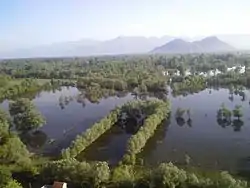Oso Kuka | |
|---|---|
 Drawing of Oso Kuka, from the June 1901 issue of the Albania newspaper of Faik Konitza | |
| Born | c. 1820 |
| Died | 1862 |
| Other names | Osman Kuka |
| Occupation(s) | a border guard and commander |
| Years active | 1862 |
| Known for | Blowing up the tower of Vranina |

Osman Bejtullah Agë Kuka, also known as Oso Kuka (c. 1812/1820–1862), was an Albanian border guard on the Ottoman-Montenegrin border. Surrounded by Montenegrin soldiers in a tower on the island of Vranjina, he blew it up, killing himself and many of the Montenegrin soldiers. In the following decades, he became a rallying figure of the Albanian independence movement and a much-celebrated character in multiple important works in Albanian literature.
Background
Two decades earlier, several battles had been fought over the possession of the island, primarily between Ottoman forces (joined by Albanians) and Montenegrins. Between 1835 and 1844, various rebellions among Albanian highlanders against the Porte led to the enforcement of local Albanian interests. On October 16, 1843, Ottoman forces numbering 12,000, led by the Governor of Shkodër, seized the island. The Ottomans arrived at the lake with 50-60 cannons and opened fire against the Montenegrin troops in the tower. The Ottomans blew up the tower, killing 7 and wounding 18, who were captured.[1] The Ottomans also seized the tower of Lesendra with 10,000 to 12,000 troops. The Montenegrins, numbering 200, fled and were met with harsh criticism by their countrymen. They tried to reclaim the island several times under Petar II Petrović-Njegoš, but failed.[2] In 1844, Albanian highlanders from Shkodër sailed with 4 ships to the island of Vranjina to build barracks in order to resist Montenegrin forces.[3]
Life
Osa Kuka was born around 1812[4][5] or 1820[6] in Shkodër, in a timariot family. His family also held several other positions in the Sanjak of Scutari, with his grandfather and other relatives being kethüda of the castle. His father, Bejtullah agë Kuka, was standard-bearer of the Albanian Pasha and Vezir, Mustafa Pasha of Shkodra of the powerful Bushati dynasty. In 1859, due to the proposition of the Albanian-Ottoman commander Hodo Sokoli, Oso Kuka was promoted to the rank of yüzbaşı of the border guards on the Ottoman-Montenegrin border.[4]

Oso Kuka himself had formed a 24-man band (çetë) that was active in the city.[7] At the head of a small group, Oso Kuka arrived on the battlefield where 8,000 Montenegrin soldiers had been besieging the fort of Vranjina. Kuka and his group were defending a secondary tower in front of the main tower. When it was surrounded, instead of surrendering, Kuka planted explosives in the tower. He then activated them when the tower was stormed by the Montenegrins, thereby killing hundreds of Montenegrin soldiers along with his group.[6] His bravery made it possible for Vranina to stay under Albanian control until 1879, when it was ceded to Montenegro by the Congress of Berlin.
Legacy
Over the decades, Oso Kuka became a major rallying figure of the Albanian national awakening. One of the most important representations of Oso Kuka in literature is found in Gjergj Fishta's epic Lahuta e Malcis, in which Oso Kuka's involvement in the war and his death comprise the first five cantos, also known as the "cycle of Oso Kuka."[8] Ndre Zadeja also wrote a melodrama titled Oso Kuka, based on his life.[9]
His residence in Shkodër houses the city's historical museum, while the Slavic-speaking population of the small village in Vranjina (modern-day Montenegro) show to visitors the so-called "house of Oso Kuka."[6]
Sources
- ↑ Jeremiji, M. Gagiću, Petar II Petrović Njegoš IZABRANA PISMA [hronološki pregled]. P. P. NJEGOŠ (Cetinje 24. oktobra 1843. ed.). Retrieved 25 March 2020.
{{cite book}}: CS1 maint: multiple names: authors list (link) - ↑ GLAVA III Mitropolija crnogorska za vrijeme mitropolita Petrovića. Mr. Aleksandar Stamatović: Kratka istorija Mitropolije Crnogorsko-primorske (1219-1999). URL: http://www.rastko.rs/rastko-cg/povijest/istorijat/istorijat_3.html, "Crna Gora u vrijeme Petra II Petrovića - Njegoša nije postigla mnogo na spoljnopolitičkom planu, čak je i izgubila. Izgubljena su 1843. tri ostrva na Skadarskom jezeru: Vranjina, Grmožur i Lesendro. Njegoš je nekoliko puta pokušao da ih povrati, ali u tome nije uspio. I do danas se u Crnoj Gori zadržala izreka, da kada neko nešto žali, kaže se: "Izgore ka vladika za Lesendrom" (Translation: Montenegro did not achieve much on the foreign policy front during the time of Petar II Petrovic - Njegos, and even lost. In 1843, three islands on Lake Skadar were lost: Vranjina, Grmožur and Lesendro. Njegos tried to retrieve them several times, but failed. Even today, the saying in Montenegro is that when one complains something, it is said: "Burn to Bishop for Lesendrom".)
- ↑ IVAN, PEDERIN (1995). OBLICI OTPORA BALKANSKIH MUSLIMANA REFORMAMA IZ CARIGRADA (PREMA SPISIMA ZADARSKE PISMOHRANE) (PDF) (Translation: In 1844.56, the construction of a barracks on Vranjina began, and the Albanians brought four ships loaded there with 2 cannons, so the chances of the Montenegrins to return these islands immediately off their coast were insignificant. ed.). Zadar: (Filozofski fakultet, Zadar). UDK 297:949.7 "18” 949.7" 18” Izvorni znanstveni članak Primljen: 15. V 1995. p. 214. Retrieved 25 March 2020.
- 1 2 Bushati, Hamdi (1998). Shkodra dhe motet v. I. Shkodër: Idromeno. pp. 510–514. OCLC 645720493.
- ↑ A.J. (January 1921). "Oso Kuka" (PDF). bksh.al. Agimi V. I, nr. 9.
- 1 2 3 Elsie, Robert (2012-12-24). A Biographical Dictionary of Albanian History. I.B.Tauris. p. 263. ISBN 9781780764313.
- ↑ "Oso Kuka, hero me vulën e popullit, jo të qeverisë". Gazeta Shqip. Retrieved 28 January 2013.
- ↑ Elsie, Robert (2006-01-08). Albanian Literature: A Short History. I.B.Tauris. p. 123. ISBN 9781845110314. Retrieved 28 January 2013.
- ↑ Banham, Martin (1995-09-21). The Cambridge Guide to Theatre. Cambridge University Press. p. 14. ISBN 9780521434379. Retrieved 28 January 2013.
External links
- http://www.bksh.al/gsdl/collect/revistaa/tmp/190106.html "Newspaper from 1896 by Faik Bey Konica"
- http://shkoder.net/oso_kuka/ "Oso Kuka – A Great Hero"
- http://argophilia.com/albania/lake-skadar.html "Lake Skadar"
- http://dome.mit.edu/bitstream/handle/1721.3/147464/204131_cp.jpg?sequence=1 "House of Oso Kuka"